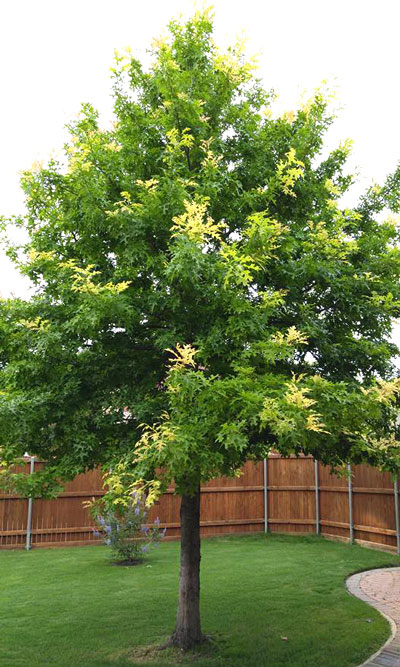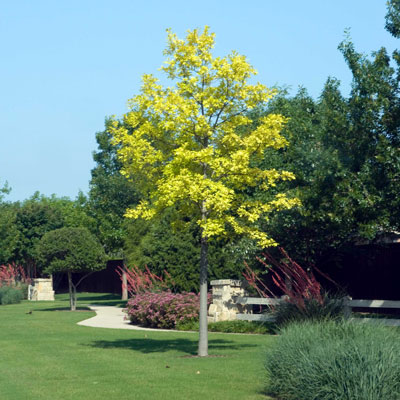Question of the Week #2: September 1, 2016
“Neil, my oak tree seems to be getting more yellow with each passing year. I’ve had it treated, but it doesn’t seem to be doing much good. What is the problem, and how do I solve it?”

Photo posted to me by a Facebook friend earlier this week. He is in Allen (DFW area), where soils have a pH of 7.5 and higher.
This may be my least favorite answer to give, because it crushes people’s hopes for their trees. They’ve planted an oak, long known to be the best trees for Texas. Unfortunately, they live in an area with alkaline soil, and the oak species they were sold cannot survive in those conditions. Let me explain.
Shumard red oaks (Quercus shumardii) are native to (and therefore adapted to) alkaline soils. Unless there is some type of trunk or root injury, they will not develop this iron deficiency symptom you see in the photos. Pin oaks (Quercus palustris) look almost identical, but they must have high levels of iron in their leaves – more iron than they can pull out of strongly alkaline soils. They should never be planted in alkaline soils in the first place. (Same thing applies to water oaks and willow oaks.)
The problem stems from iron becoming insoluble in alkaline conditions, whether in the chemistry lab or in the soil. Since plants take nutrients into their roots via liquid solution, plants that need high levels of iron (gardenias, azaleas and wisterias) will show iron deficiency in alkaline soils.
You can bypass that problem when you’re dealing with shrubs or vines by amending or replacing the soil for their limited root zones. You plant azaleas and gardenias, for example, in beds consisting of half sphagnum peat moss and half finely ground pine bark mulch.
However, you can’t go to such “heroic” soil building extremes for large trees whose roots may ultimately reach 50 feet in all directions. So you choose trees and large shrubs that are satisfied with the soil you have for them.

Pin oak on Exchange Parkway in Allen was one of several that developed iron deficiency over a 15-year period. They have all been removed now.
But, how about adding some type of iron product to correct the problem? Sure, you can do that. If it’s a soil treatment, it may contain sulfur to help acidify the soil, thereby keeping the iron soluble longer.
BUT THE REAL KICKER: You cannot afford to keep doing that kind of treatment year after year for a shade tree. What costs you $100 this year may cost you $1,000 in 15 years. In the meantime, you’d have been much farther ahead to take out the ill-suited tree and replace it with a better oak species.
How does all this happen?
• Several oak species look very similar, but not all are adapted to alkaline soils. Honest mistakes can be made.
• Nurseries may be careless in their labeling of the oak species. They may just say “red oak,” and that could include any of the red oak clan of oaks. There are dozens of species. You want to see and hear “Shumard red oak.”
• This iron deficiency problem is most common with trees that have been grown in containers and can be shipped great distances. Wholesale nurseries in the East grow and ship in containers, and their trees often go to mass merchants who buy for large regions at a time. Local independent garden centers are more likely to have trees that have been grown locally, then dug and wrapped in burlap. Local professional nurserymen also know their plants better than anyone.
Is there any way to tell them apart?
Just for general terms, Shumard red oaks tend to develop into large, rounded trees with their lower limbs ascending somewhat. Pin oaks tend to produce lower branches that hang downward, somewhat like Christmas tree boughs. There is also a variation in leaf shape and lobing. Shumard red oak leaves tend to be somewhat more deeply cut. But all of these are imprecise determinants. You’re best off buying from a local independent nursery professional who can stand behind the tree that you buy.
